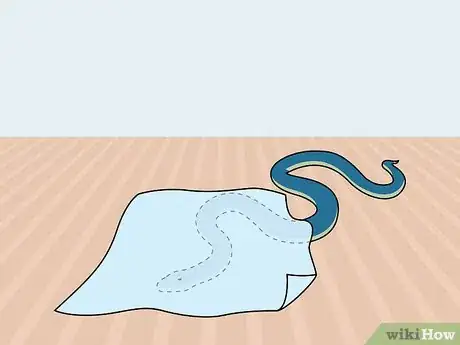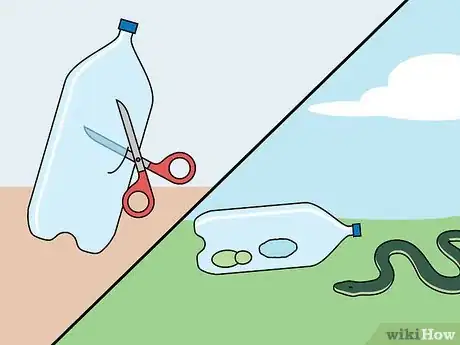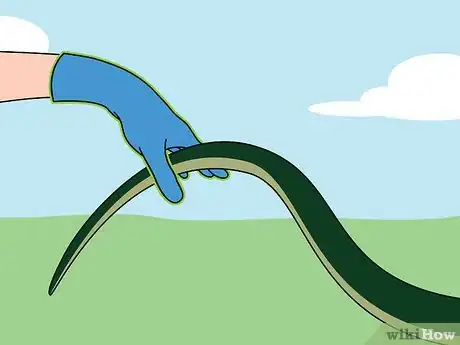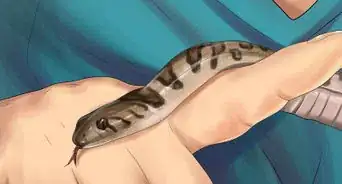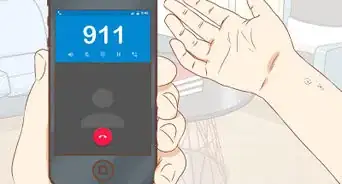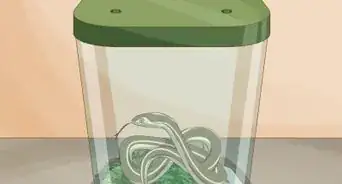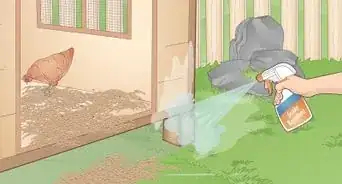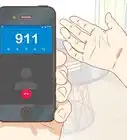This article was co-authored by Elmer Bensinger. Elmer Bensinger is a Pest Control Specialist with Eden Advanced Pest Technologies in Spokane, Washington. With over 20 years of experience, Elmer specializes in integrated pest management and products such as insecticides and rodenticides. He studied business at South Puget Sound Community College.
There are 7 references cited in this article, which can be found at the bottom of the page.
wikiHow marks an article as reader-approved once it receives enough positive feedback. In this case, several readers have written to tell us that this article was helpful to them, earning it our reader-approved status.
This article has been viewed 630,243 times.
Whether you need rid of a garden pest, or just want a closer look at these fascinating creatures. Catching a snake is possible, even for non-professionals. Snakes can be dangerous, but by taking basic precautions, you can catch one with mimimal danger.
Steps
How to Catch a Snake
-
1Coax the snake into a net. You can catch a snake using a long slender object like a badminton or tennis racket, or a long broom handle attached to a mosquito net. When you see the snake, you'll want to get quickly to the scene. Place your net in front the snake's head and coax the snake into the net. The long slender object you attach to the net should be long enough to keep your body a safe distance from the snake, while attempting to net it. Once the snake enters the net, lift up the net immediately to prevent the snake from getting out.
- Make sure your net is large enough for the snake you're aiming to catch.
- The net in front of the snake's head is effective because the snake will interpret it as a place of safety and willingly enter it.
- Approach the snake carefully and quietly. If you run over to the snake loudly you will provoke it to move away quickly, or worse, bite.
-
2Use a garbage can and broom. This is a simple way to catch a snake without having to directly handle it. Take a large garbage can and lay it on its side. Coax the snake, using the broom, into the garbage can. You can then move the garbage can to where you would like to release the snake.Advertisement
-
3Pin the snake down. Do this by placing a forked stick directly behind its head and applying pressure. The amount of pressure you will need to apply all depends on the size of the snake but it should be enough to keep it from moving its head without hurting the animal.
- There are special snake forks that can do this more effectively than a common stick.
-
4Use items around your house to catch a snake. If a snake gets into your house and you want to quickly remove it, you may have to act quickly with the items at hand. Use an old shirt or bath towel, and a pillow case. Toss the rumpled up tee shirt or towel over the snakes head and upper body. The snake will generally be afraid and coil up under the cloth.
- Without delay, place the pillowcase down over the shirt. Slide the edge firmly along the floor, scooping up the shirt and snake together. This can be done with a lingerie bag if it is large enough and you are not squeamish and know the snake is not venomous.
- Even if the snake is inside or outside coiled up, you can toss a heavy large towel over it and immediately grab it and place it in an empty box large enough to carry it in. Remove the towel. Close the box quickly and wait for it to settle down before opening it again. Make sure the bottom of the box is well sealed with tape and have someone hold the box closed until you can release it at least 5 miles from your home. If you need to transport the snake in the box yourself, make sure it is well sealed and can't get out inside the car or trunk. Make sure the location is away from other homes and in a good wild life environment where it can make a new home.
How to Make and Use a Trap to Catch a Snake
-
1Use a glue trap. This is a common and inexpensive trap available at most hardware stores. The trap will be a box with glue on the bottom. The box will have bait and lure the snake into the box where the glue will prevent it from leaving. For bait you can use frozen mice available at pet stores or common eggs from the grocery store. [1]
- Make sure to check the glue trap regularly. The snake will still be alive and immobile and after a few days could run the risk of dying of starvation.
- Choose a trap big enough for the snake you want to catch. If the trap is too small, the snake still may be able to get away, dragging the glue trap along. This will also likely kill the snake.
- Use a vegetable or olive oil to remove the snake from the glue trap. Pour olive or vegetable oil on the snake in an area you want it released. This will remove the stickiness of the glue and allow the snake to slither away unharmed.
-
2Make your own snake trap. You can do this using a plastic bottle, such as an empty two-liter, bait, and scissors. Clean the bottle so there are no smells that would scare a snake away. Cut a small hole, big enough for the snake to enter, in the bottle. Once the snake feeds on the bait it will be too large to leave back through the same hole it entered through.
-
3Use a minnow trap. Wired traps used for catching minnows are great. Put some eggs in the trap to lure the snake in. They will be able to find their way in but will be unable to get out once they eat the eggs. [2]
How to Catch a Snake by Hand
-
1Make sure the snake is safe for handling. All snakes may bite if provoked, but some pack more of a punch and are venomous. It can be hard for someone without an expertise in snakes to tell from only looking at a snake, so proceed with caution. If you suspect that a snake is venomous, do not try to catch it with your hands. Some of the most common U.S. based venomous snakes are:
- Copperhead snakes. These are found most commonly in the eastern and mid-southern states. They get their name from unique copper colored scales on their head that slowly fade throughout the rest of their body.Their markings are often triangular in shape. [3]
- Cottonmouth snake.These are usually four to seven feet in length. They are generally a dark shade of brown or a dull black. They have pupils that are shaped like slits and have a bulky body. They are found predominantly in the southern U.S., throughout Florida and the Mississippi River region. [4]
- Diamondback Rattlesnake. These can grow up ten feet long. They are recognized by their distinctive black or brown diamond patterns down their bodies outlined in a light shade of yellow. They are a rattlesnake, and as that name implies, they have a series of hollow segments on the end of their tale that create a rattle sound when its shook. They live in the southern and south western parts of the U.S. and some of Mexico. [5]
- Coral snake. These snakes can be difficult to recognize since it resembles other similar species. They are found in the eastern, southwestern, and southeastern portions of the U.S. They can grow to be around thirty inches. They are universally a red-yellow-black-yellow pattern with black heads. They are venomous, so you should be very careful if you think you spot one.[6]
-
2Grab a snake with caution. Catching a snake by hand is a little trickier, and should be done with caution. However, if you do not have any tools or nets handy, you can catch a snake using your hands. Use an object to distract the snake's head, like a stick. Firmly grasp its tail and lift the snake upwards, leaving the front part of its body on the ground, but keeping your legs and body as far away as possible. Place the snake in a pillow case or sack immediately. [7]
- If you know how to safely approach a snake, you can also grab the snake by the back of head to neutralize its chances of biting you. However, getting so close to the snake's head can be risky. If you use this method, it may be best to have a tool, such as a snake fork, that can pin the head down before you reach for it.
-
3Use gloves to handle snakes. Besides the risk of biting, snakes can also carry harmful bacteria. Make sure to use gloves to prevent your risk of catching a bacterial infection from the snake.
- If you do not have gloves, make sure to wash your hands thoroughly after touching the snake. Do not handle food or touch anyone else before you have washed your hands thoroughly.
Expert Q&A
-
QuestionHow do you remove garter snakes from your yard?
 Elmer BensingerElmer Bensinger is a Pest Control Specialist with Eden Advanced Pest Technologies in Spokane, Washington. With over 20 years of experience, Elmer specializes in integrated pest management and products such as insecticides and rodenticides. He studied business at South Puget Sound Community College.
Elmer BensingerElmer Bensinger is a Pest Control Specialist with Eden Advanced Pest Technologies in Spokane, Washington. With over 20 years of experience, Elmer specializes in integrated pest management and products such as insecticides and rodenticides. He studied business at South Puget Sound Community College.
Pest Control Specialist Grab some tongs, pick it up by the body very carefully, and set it in the woods or far away from your home. If you live in an area that's known to have venomous snakes, though, you should also call a professional snake handler for help.
Grab some tongs, pick it up by the body very carefully, and set it in the woods or far away from your home. If you live in an area that's known to have venomous snakes, though, you should also call a professional snake handler for help. -
QuestionWhat should I do if a snake bites me and no medical treatment is nearby?
 Community AnswerCheck out the helpful suggestions in this article about treating snake bites on wikiHow.
Community AnswerCheck out the helpful suggestions in this article about treating snake bites on wikiHow. -
QuestionCan a lizard willingly drop it's tail after being bitten by a venomous snake?
 James Junglejim EatonCommunity AnswerYes, if bitten by any kind of snake or other animal; though it does have to be a lizard that has fracture planes in the base of its tail. These are activated via an adrenaline flow after the lizard is caught. Not all lizards can shed their tails; monitors and iguanas, for example, cannot do this.
James Junglejim EatonCommunity AnswerYes, if bitten by any kind of snake or other animal; though it does have to be a lizard that has fracture planes in the base of its tail. These are activated via an adrenaline flow after the lizard is caught. Not all lizards can shed their tails; monitors and iguanas, for example, cannot do this.
Warnings
- Remember that snakes are wild animals and can react unpredictably when threatened. And your being near it is threatening it. Always exercise extreme caution when catching snakes.⧼thumbs_response⧽
- Incorrect advice can be fatal. If in doubt, don't.⧼thumbs_response⧽
- It may be illegal to keep a wild snake as a pet in your jurisdiction. A wild snake may also be scared of the home you are providing for it, and not eat. If you do keep a snake in captivity for more than 30 days, it will have a hard time surviving in the wild, if you decide you don't want it. So make sure you are ready to accept the responsibility of caring and maintaining a cold-blooded reptile.⧼thumbs_response⧽
- Try to avoid picking snakes up only by their tail. Most snakes cannot curl their bodies up to bite your hand, but they can easily bite your leg or even crotch. Use a long stick or other long object to cradle the first foot or so of its body. If you have to pick a snake up only by its tail, get a firm, but gentle grasp and hold it as far as possible from your body.⧼thumbs_response⧽
- Snakes' heads are remarkably flexible. Avoid grabbing the snake by the head as some snakes (especially certain venomous types) can actually bite you even when held in this fashion.⧼thumbs_response⧽
Things You'll Need
- Snake
- Snake-stick
- Transport-vessel for the snake
- Place to release the snake
- Large garbage can with lid, broom
- A hollow stick, a length of rope
- Tee shirt, pillowcase, and secure lidded container or lingerie bag
- Large plastic container with air holes
References
- ↑ http://survival-mastery.com/skills/scouting/snake-trap.html
- ↑ http://survivallife.com/quick-simple-dirty-way-to-deal-with-snakes/
- ↑ http://www.snake-removal.com/copperhead.html
- ↑ http://www.snake-removal.com/cottonmouth.html
- ↑ http://www.snake-removal.com/diamondback.html
- ↑ http://www.snake-removal.com/coral.html
- ↑ http://www.wildlifeanimalcontrol.com/snakecatch.html
About This Article
To catch a snake, attach a mosquito net to a long slender object like a broom handle or a tennis racket. Make sure the net is large enough to fit the snake's entire body and that the handle is long enough to keep your body at a safe distance. When you see the snake, place the net in front of its head, and it will likely go right in, thinking it's a safe place to hide. Alternatively, if you'd prefer not directly handling the snake, use a broom to gently move a snake into a container, like a garbage can on its side. To learn how to make your own snake trap, keep reading!



